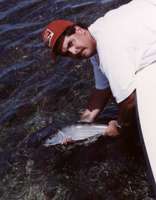
Pursuing Wintertime Bonefishing
by Capt. Barry Hoffman
(page 2)
 The
winter time weather has another effect on bonefish. It is during this time of
the year bonefish can be found in schools of fifty to over two hundred as they
migrate along the shorelines of the upper Keys. The larger numbers of fish may
be due to the cold water driving bonefish out of Florida Bay northward as well
as the bonefish of Biscayne Bay southward. There are generally two schools of
thought as to why they do this. One, it is simply a migratory pattern the fish
get into to find a more tolerable water temperature. The second is that it is
part of a spawning ritual. Although very little is known about the spawning
habits of Albula vulpes, it is believed these large schools may spawn offshore
as well as inshore while on the flats. While on the move in these rolling masses,
the release of the roe from a female, encourages the males to fertilize them while
swimming alongside. This is known as broadcast fertilization. Occasionally
while releasing a bonefish, these large, pre-spawning fish will release their
milt.
The
winter time weather has another effect on bonefish. It is during this time of
the year bonefish can be found in schools of fifty to over two hundred as they
migrate along the shorelines of the upper Keys. The larger numbers of fish may
be due to the cold water driving bonefish out of Florida Bay northward as well
as the bonefish of Biscayne Bay southward. There are generally two schools of
thought as to why they do this. One, it is simply a migratory pattern the fish
get into to find a more tolerable water temperature. The second is that it is
part of a spawning ritual. Although very little is known about the spawning
habits of Albula vulpes, it is believed these large schools may spawn offshore
as well as inshore while on the flats. While on the move in these rolling masses,
the release of the roe from a female, encourages the males to fertilize them while
swimming alongside. This is known as broadcast fertilization. Occasionally
while releasing a bonefish, these large, pre-spawning fish will release their
milt. The
initial stages of the life of a bonefish begin as the eggs are fertilized.
The fertilized eggs hatch into an eel-like and transparent larva. These
larva spend several months drifting in the offshore ocean currents where they
reach a length of about two inches. At that time a unique process occurs. The
bonefish larva shrinks to about three-quarters of an inch, then begin to form
tiny fins. The bonefish will also change from its previous transparent color to
silver. The bonefish will then begin to grow again. At this point
the larva looks much like a miniature bonefish. Once they reach about an inch
in length, they seek the safety of the mangrove roots where they’ll begin their
life upon the
shallow flats.
 Back
to the fishing. One important aspect to consider while fishing these huge moving
schools is to find a point that the bonefish will have to navigate around while
traversing the shoreline. As the fish make their way up and down the edges
of the oceanside flats, there are shallower points they will invariably have to
swim around. Find one of these points, and stay on it. The bonefish will
usually reveal themselves by a surface wake as they move in mass. They can
be tough for a novice to detect. They are simply a pattern of waves that doesn’t
match the conditions of the wind. Usually the larger schools will ‘push’ a large
section of water as they move erratically across a flat. These ‘pushes’
of water can be seen from three hundred feet or more on a calm day. While
fishing in these huge schools you may be able to cast over and over again right
into the moving fish. However, some days the fish are moving quickly and
without want of anything placed in their path. Other days the fish are less hurried
and more apt to take a fly or bait.
Back
to the fishing. One important aspect to consider while fishing these huge moving
schools is to find a point that the bonefish will have to navigate around while
traversing the shoreline. As the fish make their way up and down the edges
of the oceanside flats, there are shallower points they will invariably have to
swim around. Find one of these points, and stay on it. The bonefish will
usually reveal themselves by a surface wake as they move in mass. They can
be tough for a novice to detect. They are simply a pattern of waves that doesn’t
match the conditions of the wind. Usually the larger schools will ‘push’ a large
section of water as they move erratically across a flat. These ‘pushes’
of water can be seen from three hundred feet or more on a calm day. While
fishing in these huge schools you may be able to cast over and over again right
into the moving fish. However, some days the fish are moving quickly and
without want of anything placed in their path. Other days the fish are less hurried
and more apt to take a fly or bait.
![]() You can contact
Capt. Barry Hoffman at:
You can contact
Capt. Barry Hoffman at:
Email: [email protected]
Or, visit his Web site
http://flatsguide.com/
| Travel | Marketplace | Weather | Jump Aboard | Feedback |
| Fishing Links | Forum | Search | Home |
Questions and comments: Please use our Contact Form.